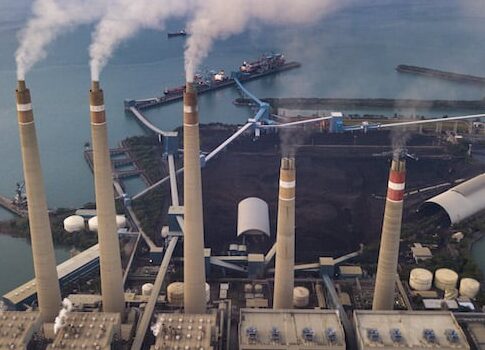Indonesia’s Coal Emissions at Record High, Up 33% in 2022
Indonesia’s coal emissions in 2022 hit a record high, as per preliminary analysis, which makes the country one of the biggest emitters of carbon from fossil fuels worldwide.
The data analyzed was from the Indonesian Ministry of Energy and Mineral Resources (ESDM), showing that coal consumption in the country is highest ever in 2022 than any year. It jumped by 33%, from 559 million barrels of oil equivalent (BOE) in 2021 to 746 BOE in 2022.
Highest Ever Growth in Coal Emissions
As seen in the chart, coal has spiked up with a huge margin in comparison to other energy sources. This increase in coal burning also resulted in skyrocketing greenhouse gas emissions from coal and other fossil fuels.
According to the Global Carbon Project, the organization that calculated CO2e emissions from Indonesia’s fossil fuel burning, the rise in coal caused the Asian country’s GHG emissions to increase massively by more than 20%.
The top 10 biggest carbon emitters haven’t seen this increase in the last fifteen years, says one senior analyst in the organization.
Increases in oil and gas, plus coal, emissions bring Indonesia’s total fossil fuel CO2 emissions to 619 million metric tons.
With these increases, Indonesia will be the world’s 6th-highest fossil polluter in 2022, up from the 9th place in 2021. The top 3 spots go to the U.S., Saudi Arabia, and Russia.
If this trend continues this year, the Southeast Asian nation will hold the 6th spot, for sure. Still, the country’s CO2e footprint per capita (2.7 tonnes) remains lower than that of the United States (15 tonnes).
Global average for emissions intensity is 7.5 tonnes per capita.
Indonesia is the 3rd-largest coal producer in the world and is a major coal consumer itself. And with new coal plants on the pipeline, the nation’s coal consumption will grow consistently until 2029.
There’s also not enough intent and action to slow down coal mining in the country, more so decommission the mines. This is amid Indonesia’s commitment to reach net zero emissions by 2060.
As per ESDM estimates, the country will produce more coal in 2023, at 694 million tonnes. That’s a 5% increase from the 2022 target of 663 million tonnes. This projection is largely due to the expected high demand from India and China, the country’s major coal export partners.
Indonesia’s 2022 coal sales to Europe also reached historical highs. This is largely due to a shift to coal among European utilities prompted by high gas prices. The EU embargo on Russian coal because of its conflict with Ukraine enabled Indonesian suppliers to tap the European market.
Is the Energy Transition Still Possible?
With the growing coal production and its carbon emissions, will Indonesia be able to still reach its energy transition targets?
The answer to this question is crucial as experts said that it significantly impacts the 1.5°C global temperatures threshold. After all, the Southeast Asian largest economy is one of the world’s largest emitters.
The country inked a landmark deal last year called the Just Energy Transition Partnership (JETP) in which developed nations (G7) will invest $20 billion in Indonesia to help it ramp up transition to renewable energy.
This historic agreement will allow the country to limit power sector sectors to 29 million Mt by 2030. But this will be possible if Indonesian coal-fired power plants are retired and new projects are frozen.
Adding more coal plants is part of President Joko Widodo’s flagship program to add 35 gigawatts to Indonesia’s national grid. The program calls for building hundreds of different kinds of power plants but most of the increase in capacity will be from coal-fired plants.
One more major factor driving coal production up is the growing demand in the metals industry, particularly the nickel sector.
Complementing the Soaring Demand for Lithium-Ion Batteries
Indonesia is the world’s largest producer of nickel, a key element used in making lithium-ion batteries for electric vehicles and renewable energy storage.
The current administration wants to make the country an EV powerhouse. That means relying on Indonesia’s abundant nickel reserves, whose production also increased by 60% last year.
Given that the nation’s power grid is largely run by coal (43%) and mining nickel is highly carbon intensive, it contributes largely to the rise in coal production and emissions.
Moreover, the carbon per KwH of power generation in Indonesia is so much more than most other nickel producers. For example, comparing it to Canada, the Asian country will produce about 9x as much carbon per KwH of electricity.
Processing nickel requires smelters which are powered by coal-fired electricity plants, a.k.a. captive plants. New smelters were built in 2017 and started operations in 2019.
Unfortunately, retiring or replacing these plants are difficult; it needs investments in new infrastructure. And shutting them down means halting the smelters critical for processing battery-grade nickel.
With that, it seems that Indonesia’s best hope to achieve its climate targets in the power sector is to stop building new fossil fuel plants and rather invest in renewable energy infrastructure.
Last month, a group of global experts, Coal to Clean Credit Initiative (CCCI), announced they are developing a world-first “coal-to-clean” carbon credit program that incentivizes the transition away from coal-fired power plants to renewable energy in emerging economies.
The post Indonesia’s Coal Emissions at Record High, Up 33% in 2022 appeared first on Carbon Credits.



